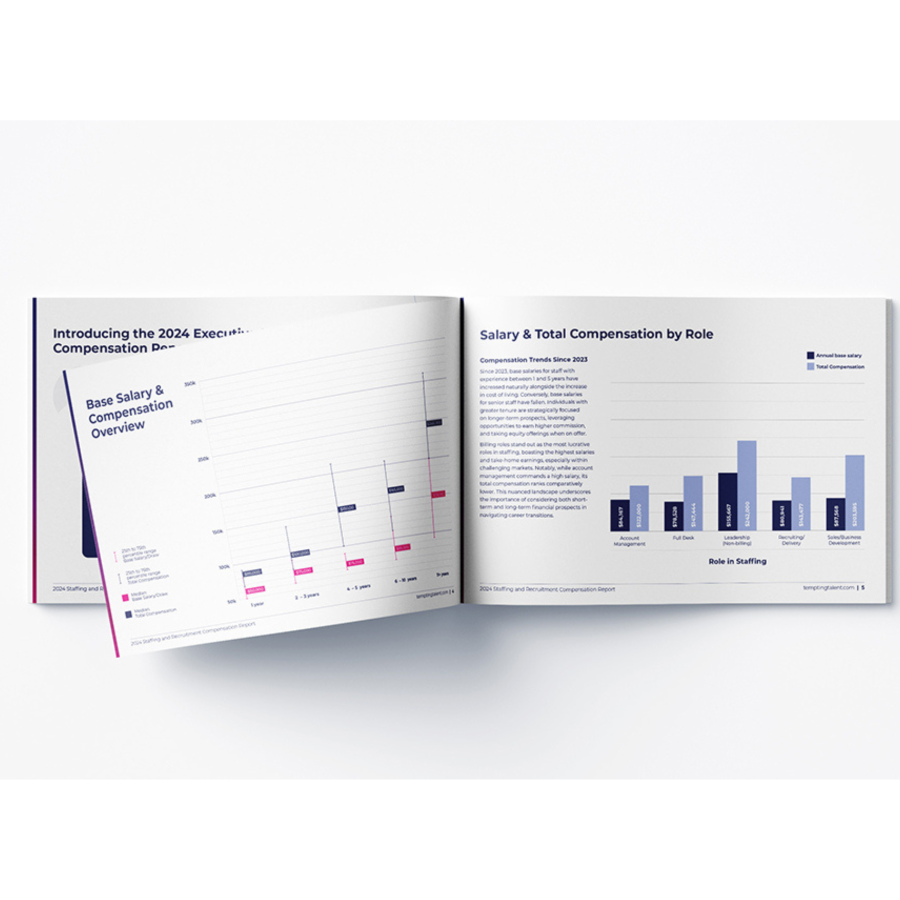Benchmark Your Compensation
Each year, Tempting Talent provides an in-depth overview of the US Staffing industry's compensation benchmarks, bringing transparency to professionals seeking new positions, and ensuring employers remain competitive.
Alongside the latest compensation data, the report explores most important benefits to professionals, learning and development programs in Staffing, moving roles, and working environments.
Download the report

2025's Staffing Market
Welcome to Tempting Talent’s 2025 Staffing Compensation & Market Insights Report, where we delve into the intricacies of the US staffing market’s current landscape, specifically focusing on compensation elements such as salaries, benefits, equity, culture, and working styles.
Staffing continues to experience growth and evolution, with firms expanding in terms of headcount, reputation, and revenue on an annual basis, while new players continually enter the market. Our report aims to provide valuable insights to both professionals seeking new opportunities and hiring managers aiming to benchmark their firms’ offerings against the wider market. If you find these findings intriguing or wish to discuss them further, feel free to reach out to me or the team.
Staffing Compensation & Market Insights Report
What's Inside?
Compensation Data provided by over 500 Staffing Professionals in the US, analysed against job role, attributed billing, and market.
Data on moving roles in the last 12 months
Learning and Development Programs in Staffing
Benefits data, including 401(k), PTO, health insurance and maternity/paternity leave.
Working environment analysis comparing working from home, hybrid or fully in office.
Methodology
The purpose of this methodology is to provide a clear understanding of the approach utilized in conducting a survey aimed at Staffing professionals. This survey aimed to gather insights into various aspects of the Staffing industry, including compensation data (base and total package), working environments, trends, challenges, and best practices.
Survey Design:
Objective: The primary objective of the survey was to understand the perspectives and experiences of Staffing professionals as well as gather data that could provide industry wide benchmarks.
Questionnaire Development: A comprehensive questionnaire was designed to cover key areas such as compensation, industry trends for 2025, important benefits, learning and development programs, and challenges faced by Staffing professionals.
Pilot Testing: Prior to the official launch, the questionnaire underwent pilot testing to ensure clarity, relevance, and effectiveness in eliciting the desired information.
Question Types: The questionnaire included a mix of multiple-choice questions, Likert scale items, and open-ended questions to capture a broad spectrum of responses.
Sampling Method:
Target Population: The target population comprised professionals actively involved in Staffing activities across various industries in the US.
Sampling Technique: A combination of convenience sampling and purposive sampling techniques was employed to reach out to a diverse pool of Staffing professionals.
Sample Size: The survey aimed to collect responses from over 400 Executive Search and Staffing professionals to ensure adequate representation and statistical reliability.
Data Collection:
Online Survey Platform: The survey was administered using a reputable online survey platform, ensuring ease of access and data security.
Distribution Channels: The survey link was distributed via professional networks, industry forums, and targeted email invitations to reach the intended audience.
Data Collection Period: The survey was conducted over a 1 month in January and February 2025 to allow sufficient time for respondents to participate and provide thoughtful responses.
Data Analysis:
Quantitative Analysis: Responses to multiple-choice and Likert scale questions were subjected to quantitative analysis using statistical tools to identify trends, patterns, and correlations.
Qualitative Analysis: Open-ended responses were analyzed thematically to extract insights, opinions, and anecdotes shared by respondents.
Triangulation: Triangulation of quantitative and qualitative findings was performed to validate and enrich the understanding of key themes emerging from the data.
Ethical Considerations:
Informed Consent: Participants were provided with clear information about the purpose of the survey and their voluntary participation. Consent was obtained before proceeding with the survey.
Anonymity and Confidentiality: Respondents were assured of the confidentiality of their responses, and measures were implemented to anonymize data to protect the privacy of participants.
Limitations:
While efforts were made to ensure the representativeness of the sample, the findings may be subject to biases inherent in survey research, such as self-selection bias.
The generalizability of findings may be limited to the population of Staffing professionals who participated in the survey.
Conclusion:
The methodology employed in this survey aimed to uphold standards of rigor and validity in data collection and analysis, thereby providing meaningful insights into the perspectives and practices of Staffing professionals.
This methodology outlines the systematic approach adopted in conducting the survey, ensuring reliability and credibility in the generation of findings and conclusions.
Benchmark Search and Recruitment Professionals' Compensation, Benefits, PTO, and more...
Our Compensation Reports for 2025 are now available to download.
Discover the latest insights to benchmark your package against the wider industry or to inform your hiring strategy for 2025.

